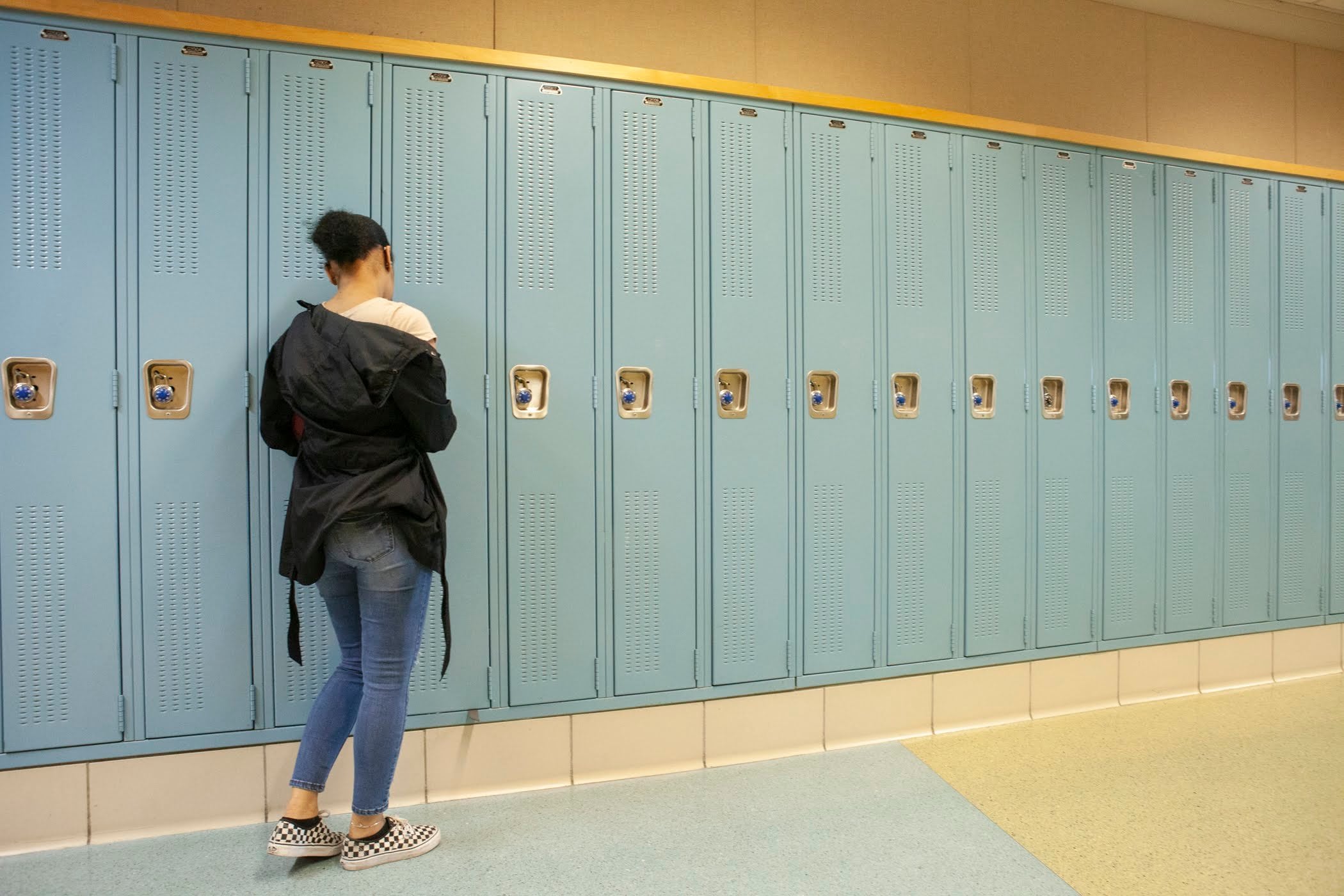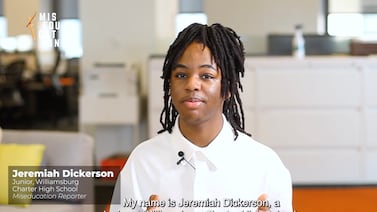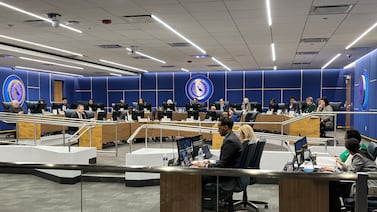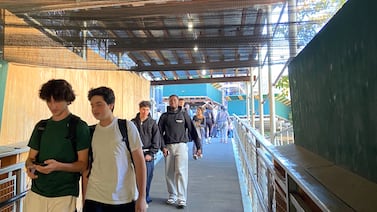Maile Solis’ son wants to follow an older sister to Lane Tech College Prep, one of Chicago’s selective-enrollment high schools on the Northwest Side. Across the city on the Far South Side, Orzella Denton’s daughter dreams of landing a spot in one of the district’s fine arts programs.
But both parents are monitoring grades anxiously — and bracing for a high school admissions process profoundly disrupted by the pandemic.
The COVID-19 crisis has added pressure and uncertainty to a process that was already grueling and high-stress for many families. The upheaval forced the district to make temporary changes — from hosting virtual open houses to letting students choose which recent test scores to use — but some families and advocates worry about what the high-stakes ritual might look like next year and beyond amid the pandemic’s academic fallout. They argue a crisis that has widened academic disparities should lead the district to rethink the process, which has left Black and Latino students and those with special needs underrepresented in some of the city’s most coveted programs.
“This would be a great time to make compassionate changes to the process and really consider the neediest students,” said Mary Fahey Hughes, the special education parent liaison for the advocacy group Raise Your Hand, who is pressing the district to do away with minimum requirements for grades and test scores.
Across the country, the pandemic and a reckoning over race have intensified a debate over how selective high schools determine who gets in. In Boston, an overhaul of the application process for the city’s exam schools stirred protests and resulted in a parent lawsuit.
In Chicago, the district is gearing up to release admissions decisions for next fall at the end of the month, along with data that would show if the district experienced the drop in high school applications some other districts have reported. Asked about changes the district might be weighing, officials declined to comment for now. As part of a broader initiative to improve the high school experience, the district said earlier this year it would earmark about 15% of seats at selective-enrollment high schools for students with special needs, where they now make up only 6% of the student body.
Some progress, a way to go
The high school application process is considered a critical milestone for Chicago students. More than 25,000 eighth graders use the district’s universal application platform each year, though all students are guaranteed a spot in their neighborhood high schools. Mayor Lori Lightfoot and district leaders have said making close-to-home options more attractive is a priority. But historical disinvestment and enrollment losses in some schools continue to prompt families to look beyond their neighborhood boundaries for campuses with specialized programs and more robust course lists.
The district launched GoCPS four years ago in a bid to streamline a cumbersome earlier process. The platform helped reduce the number of eighth graders stranded without any offers while some peers sat on multiple acceptances well into the summer.
Chicago uses seventh-grade grades and the NWEA’s MAP test scores for admissions into specialized programs, with a separate exam for students seeking entry into the city’s 11 selective-enrollment schools. The district also factors in a student’s neighborhood in an effort to boost representation for students from low-income parts of the city.
Last year, about 15% of students who applied to selective-enrollment high schools got their first choice, and just more than half of applicants to all GoCPS programs got their first choice. About 80% landed one of their top three choices, according to district data.
“There are a lot of things the GoCPS system has added to promote equity,” said Kate Phillippo, an associate professor at Loyola University and the author of a book about high school admissions in the city. “But there is still a long way to go.”
Last year forced changes to the process: With shuttered campuses last spring, the district did not administer the MAP test, so eighth graders instead got to choose the highest of their previous three scores. In recognition of barriers to remote learning access, the district also used either a student’s final grades for the year — or the average of their first- and second-quarter grades. It did not consider attendance, and it pushed back the application deadline to early January. It offered students a string of dates to sit for the selective-enrollment exam, even as some families and educators sharply criticized the decision to host that test in person during a surge in COVID-19 cases last winter.
Phillippo said she has long advocated for virtual open houses and auditions, which can introduce families to programs in unfamiliar neighborhoods, while removing transportation, child care and other hurdles to participating. Giving students more time to research schools and complete their applications this winter was “the humane thing to do given multiple interlocking crises,” she said.
The choice of test scores added a measure of flexibility. But students had to go with scores they did not know would end up carrying high stakes when they took those tests — in some cases back when they were sixth graders.
Yolanda Luna-Mroz, chief programs officer at High Jump, a nonprofit that helps low-income students with high school applications, said, without a doubt, the pandemic made the process more stressful for families. She suspects the district will see a marked drop in applications, and that some students found it harder to access competitive programs. She said families who don’t have the technology savvy needed to submit the online applications can usually walk into their school building and get help. In previous years, High Jump hosted group sessions to troubleshoot and answer questions.
This year, the organization offered more than its usual one-on-one student support to families, straining its capacity like never before. The nonprofit hosted district officials at its virtual information session last fall, which it recorded and promoted in English and Spanish, to explain the process and this year’s changes. Luna-Mroz also said she hopes virtual events that improved access for some families are here to stay.
“In some ways, forcing schools to adjust and adapt, there was some progress,” she said.
A lot of confusion
Families of seventh graders are already bracing for how the high school application process might play out next year.
Solis’ son at Taft Academic Center spent the seventh grade in a new school, where he hasn’t yet set foot or met his teachers in person. (Academic center buildings remained closed even as other middle schools reopened in March.) The school told families earlier this spring that the district would likely administer the MAP test in May, but that without recent testing data, schools likely would not be able to help with preparing for it as some have done in previous years. Solis and other parents signed up for a private test prep program — only to hear from the school more recently that the district might not administer the test this spring after all.
“There’s just a lot of confusion and no communication at all from CPS — not a word,” said Solis. “There does not seem to be a plan and that’s really concerning to me as a parent.”
But Solis also said she thinks a lot about how the crisis is putting families with limited resources at an even larger disadvantage. When her son’s school-issued Chromebook turned out to be too slow for live virtual classes, the family was able to buy another device. When her son struggled in some classes, the family hired a tutor.
“I’m fully aware that’s not something many parents have been able to do,” she said.
Denton, the mom of the seventh grader at Parker Community Academy, chose to keep her daughter learning from home for the remainder of this school year, believing it’s not yet safe to return to the school building. But she worries about how remote learning has tested the girl: The family’s internet connection has been often spotty, and her daughter has found it more difficult to get consistent guidance from teachers.
“You have an A and B child, and you turn around, and the grades have dropped,” Denton said.
Hughes of Raise Your Hand, who has a son in the seventh grade, said: “We’ve got to really push this year to get his grades up. It’s just criminal we have to worry about that on top of everything else.”
Seeking bold changes
Advocates say the district should think boldly about further overhauling the process for next year to account for the uneven impact of the pandemic. The crisis has widened inequities in a host of ways — for students who are learning English, caring for or overseeing remote learning for younger siblings, navigating remote learning without parents guiding them at home, or dealing with grief and loss amid a pandemic and an uptick in violence that have both hit predominantly Black and Latino neighborhoods in Chicago much harder.
Hughes, who has an older son in special education, wants the district to eliminate MAP and grade “cut scores.” She said these minimum requirements can block students with special needs from even applying, not only to academically competitive programs but also to the vocational and fine arts programs that can be a great fit for them. By her estimate, about 220 of the 318 GoCPS programs use MAP or grade cut scores or both, including almost all of the district’s 35 specialized art programs. Hughes said principals have an incentive to set these minimum requirements higher to help maintain or improve their school rankings.
“You don’t deserve to be in these programs because you don’t test well,” she said. “It’s infuriating to me. It’s a great time to rethink inclusion and support.”
Offering students with disabilities a portion of the seats at selective-enrollment schools, where some families worry their students will not get enough specialized support, is not enough, Hughes argued. Students with special needs have often struggled particularly amid the pandemic, with some unable to access remote learning altogether.
Phillippo said the district’s changes this year made sense, but a deeper overhaul might be needed for next year.
“Counting grades and test scores next year seems really problematic to me,” she said. “Young people are on such uneven footing.”
She noted Boston’s decision to drop the admissions test for its three highly competitive exam schools, instead basing decisions on grade point averages and, in a tiered system officials there said was inspired by Chicago’s, factoring in zip codes, with priority for students living in lower-income neighborhoods. District leaders there said the approach would increase the representation of Black and Latino students, but the changes have resulted in major pushback. San Francisco’s premiere Lowell High School went even further, replacing a review of students’ academic records with a lottery system.
Luna-Mroz of High Jump said the data on application outcomes the district is slated to release April 30 should inform how the city approaches the process next year. Any changes should also be rooted in long-term shifts the pandemic is likely to bring, such as likely making digital assignments and remote interaction with students a permanent fixture.
“We’re still in a pandemic, and we’re living in the moment,” she said. Still, she added, “Sometimes these kinds of emergencies spark change and force us to innovate and adapt.”






